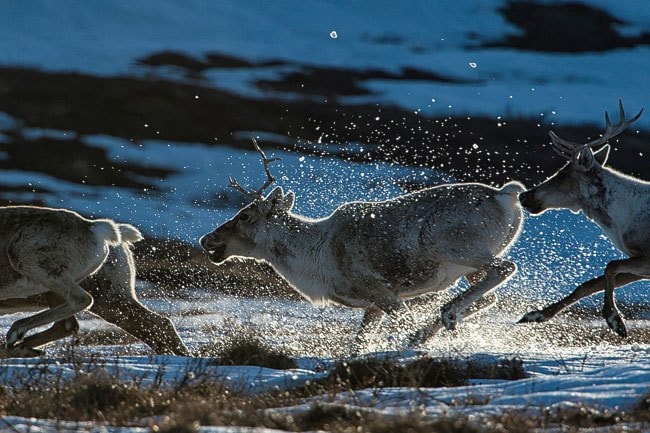Photographers are known for going to extreme lengths to get the shot. For Yukon photographer Peter Mather and Aussie filmmaker Marty O’Brien, going the extra mile is an understatement.
Mather, an internationally published photographer, has been pouring a considerable amount of time, money, and effort into capturing stunning images of the Porcupine caribou herd in the Arctic circle, and hopes to eventually sell the story to National Geographic.
O’Brien, a filmmaker originally from Melbourne, Australia, joined the trek in hopes of producing a documentary on how far photographers will go in order to get a photo.
Having captured the herd in snowless months, as well as documenting the cultural significance of the caribou to the Vuntut Gwitchin people, Mather wanted to photograph the epic winter journey. The herd - which numbers 170,000 strong - migrates every spring from inland Yukon and Alaska to the shores of the Beaufort Sea to calve.
It’s a long and dangerous journey for the caribou, says Mather. “They’re chased by wolves and bears and cross these crazy rivers in winter and it’s over mountains.” Natural hazards are not the only danger looming for the caribou, says Mather; there are also human threats. “The calving grounds - it’s a sacred place for the Gwitchin - it sits on top of a big pile of oil.”
One possible reason the story of this migration is less told is that it is exceedingly hard to get to. To access the remote region where the caribou would be, a plane was chartered to carry the duo and their gear from Old Crow to Margaret Lake, an uninhabited landing strip near the Firth River. However, a minor technical problem on the plane required the pilot to set down 100 km away from the target location. The only way to make up the ground was to ski the rest of the way.
“It was just absolutely brutal,” says O’Brien. Each towing behind them in sleds close to 300 pounds (140 kilograms) of gear, Mather and O’Brien skied their way slowly over the frozen land. “With that amount of weight it was just like hauling a snowplow,” says Mather.
“The 10 days we spent skiing, the most exciting part of our day was easily when we were done,” says Mather. “You’d get out of your sleeping bag at 10 o’clock at night, you’d be out of your sleeping bag for 10 minutes, and we’d be like ‘Hey Marty! 12 hours we’ll be back in our sleeping bags!’ We were just so excited, because you’re just exhausted.”
Base camp was finally set up on May 7 after coming across a picturesque valley. Then the waiting game began.
Biologists had forecasted a late migration for this year, estimating the caribou to pass by between the 10th and 18th of May.
With plenty of time on their hands and not a lot to fill it with, Mather and O’Brien began to develop cabin fever. In their collective 600 pounds of gear, only a single iPod would help them pass the time. The two would swap the device, listening to an audio book of Game of Thrones, rationing the two hours of battery they could get every day. “To listen to John Snow go beyond the wall, and feel very beyond the wall, that was really cool,” says O’Brien.
When a BBC film crew in the region offered via satellite phone to drop off some supplies with their helicopter, Mather and O’Brien made the most of the offer. “I think he was meaning staple diet, good nutritious supplements to get us through the trip,” said O’Brien. “And we ordered Pringles, Pop Tarts, whiskey - I think 16 chocolate bars.” After camping out for days on the desolate tundra, a little pick-me-up was sorely needed. “It was kind of like Christmas come early,” said O’Brien.
Conditions for a good photo were ripe when Mather and O’Brien arrived at their camp, but the caribou were not coming. “For this National Geographic story, just for them to buy it, I need a couple images that are just incredible images,” Mather says. “You need to have an image that is beautiful and tells a story.”
A picture floating around in Mather’s head before setting out was a line of thousands of caribou in the snow, the herd stretching out to the horizon. However, as the days passed, the temperatures started to warm, causing the snow to disappear rapidly. “You could see the photo melting away in front of your eyes,” says Mather.
By the time the caribou arrived, temperatures soared into the double digits, causing rivers to weave through the quickly melting snow. One particularly troublesome stream was between the base camp and the spot where Mather was photographing. “This creek was just our nemesis,” says Mather. “It ended up killing two of my cameras.”
With the caribou herd moving through the area over a number of days, Mather and O’Brien made the best of the situation, capturing what they could amidst difficult circumstances. The snow was almost gone, which meant the caribou were more scattered than Mather had anticipated.
“They’re beautiful photos, but they’re not National Geographic photos,” says Mather. “A National Geographic photo is a beautiful photo that also tells an incredible story and makes people connect to the animal right away.”
Mather has been working on capturing the story of the caribou for over two years already, and even with this setback he is excited to continue the project. It could still be a few years before the photos would be displayed on the pages of a magazine, he says. “I’ve been working on it for two and a half years, it’s going to be another three or four years. And even then it might not work.”
Even with torturous conditions and a disappointing return on investment, Mather and O’Brien have already set their sights on next season. “It’s the biggest itch,” says Mather. “I’m dead set on going back.”
Contact Joel Krahn at
joel.krahn@yukon-news.com
